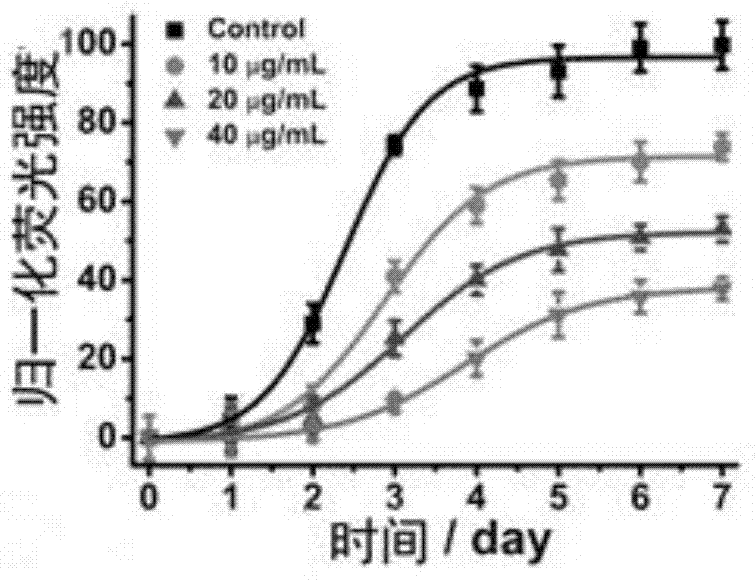Method for inhibiting aggregation of Abeta by using WS2 nanosheet and method for de-aggregating formed Abeta fiber aggregate
A technology of nanosheets and aggregates, applied in the field of medicine, can solve the problems of weak depolymerization ability, low blood-brain barrier permeability, and poor targeting.
- Summary
- Abstract
- Description
- Claims
- Application Information
AI Technical Summary
Problems solved by technology
Method used
Image
Examples
Embodiment 1
[0046] WS 2 Nanosheets inhibit self-aggregation of Aβ1-40:
[0047] Step 1: Preparation of WS 2 Nanosheets: 100mg of WS in nitrogen atmosphere 2 The powder was dissolved in 1.6M n-butyllithium solution and reacted. After 2 days, the mixture was filtered with Whatman#41 filter paper and washed 3 times with 100 mL of hexane, and 300 mL of deionized water was added to the obtained semi-dry precipitate, and ultrasonic treatment was performed for 1 hours, then the solution was centrifuged, washed 3 times with deionized water to remove lithium ions and undispersed large particles, and the supernatant was collected and dialyzed with deionized water for 5 days to obtain WS 2 Nanosheets;
[0048] Step 2: First, Aβ1-40 (product number U10012, purchased from American Peptide) was dissolved in hexafluoroisopropanol at a concentration of 1 mg / ml, the bottle was sealed, and shaken at 4°C for 2 hours to promote It was completely dissolved, and the stock solution was stored at -20°C. Befo...
Embodiment 2
[0054] WS 2 Nanosheet photothermal depolymerization of formed Aβ1-40 fiber aggregates:
[0055] Step 1: Preparation of WS 2 Nanosheets: 100mg of WS in nitrogen atmosphere 2 The powder was dissolved in 1.6M n-butyllithium solution and reacted. After 2 days, the mixture was filtered with Whatman#41 filter paper and washed 3 times with 100 mL of hexane, and 300 mL of deionized water was added to the obtained semi-dry precipitate, and ultrasonic treatment was performed for 1 hours, then the solution was centrifuged, washed 3 times with deionized water to remove lithium ions and undispersed large particles, and the supernatant was collected and dialyzed with deionized water for 5 days to obtain WS 2 Nanosheets;
[0056] Step 2: First, Aβ1-40 (product number U10012, purchased from American Peptide) was dissolved in hexafluoroisopropanol at a concentration of 1 mg / ml, the bottle was sealed, and shaken at 4°C for 2 hours to promote It was completely dissolved, and the stock soluti...
Embodiment 3
[0060] WS 2 Nanosheets inhibit Aβ1-40 aggregation in cerebrospinal fluid
[0061] The reaction conditions and steps are the same as in Example 1, except that the treated Aβ1-40 and WS 2 Nanosheets were incubated in cerebrospinal fluid.
[0062] Figure 9For Example 3WS 2 The ThT fluorescence detection map of the inhibitory effect of nanosheets on Aβ1-40 aggregation, Figure 9 It can be seen that in CSF, WS 2 Nanosheets can still inhibit the fibrosis process of Aβ1-40 in a concentration-dependent manner.
PUM
 Login to View More
Login to View More Abstract
Description
Claims
Application Information
 Login to View More
Login to View More - R&D
- Intellectual Property
- Life Sciences
- Materials
- Tech Scout
- Unparalleled Data Quality
- Higher Quality Content
- 60% Fewer Hallucinations
Browse by: Latest US Patents, China's latest patents, Technical Efficacy Thesaurus, Application Domain, Technology Topic, Popular Technical Reports.
© 2025 PatSnap. All rights reserved.Legal|Privacy policy|Modern Slavery Act Transparency Statement|Sitemap|About US| Contact US: help@patsnap.com



